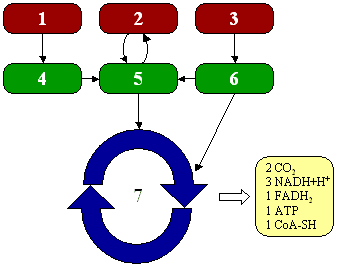Citric acid cycle
|
|
The citric acid cycle (also known as the tricarboxylic acid cycle, the TCA cycle, or the Krebs cycle) is a series of chemical reactions of central importance in all living cells that utilize oxygen as part of cellular respiration. In these aerobic organisms, the citric acid cycle is a metabolic pathway that forms part of the break down of carbohydrates, fats and proteins into carbon dioxide and water in order to generate energy. It is the second of three metabolic pathways that are involved in fuel molecule catabolism and ATP production.
The citric acid cycle also provides precursors for many compounds such as certain amino acids, and some of its reactions are therefore important even in cells performing fermentation.
| Contents |
History
The citric acid cycle is also known as the Krebs cycle after Sir Hans Adolf Krebs (1900-1981), who proposed the key elements of this pathway in 1937 and was awarded the Nobel Prize in Medicine for its discovery in 1953.
Location of cycle and inputs and outputs
The citric acid cycle takes place within the mitochondria in eukaryotes, and within the cytoplasm in prokaryotes.
Fuel molecule catabolism (including glycolysis) produces acetyl-CoA, a two-carbon acetyl group bound to coenzyme A. Acetyl-CoA is the main input to the citric acid cycle. Citrate is both the first and the last product of the cycle (Fig 1), and is regenerated by the condensation of oxaloacetate and acetyl-CoA.
| Molecule | Enzyme | Reaction type | Reactants/ Coenzymes | Products/ Coenzymes |
|---|---|---|---|---|
| I. Citrate | 1. Aconitase | Dehydration | H2O | |
| II. cis-Aconitate | 2. Aconitase | Hydration | H2O | |
| III. Isocitrate | 3. Isocitrate dehydrogenase | Oxidation | NAD+ | NADH + H+ |
| IV. Oxalosuccinate | 4. Isocitrate dehydrogenase | Decarboxylation | ||
| V. α-Ketoglutarate | 5. α-Ketoglutarate dehydrogenase | Oxidative decarboxylation | NAD+ + CoA-SH | NADH + H+ + CO2 |
| VI. Succinyl-CoA | 6. Succinyl-CoA synthetase | Hydrolysis | GDP + Pi | GTP + CoA-SH |
| VII. Succinate | 7. Succinate dehydrogenase | Oxidation | FAD | FADH2 |
| VIII. Fumarate | 8. Fumarase | Addition (H2O) | H2O | |
| IX. L-Malate | 9. Malate dehydrogenase | Oxidation | NAD+ | NADH + H+ |
| X. Oxaloacetate | 10. Citrate synthase | Condensation | ||
| XI. Acetyl-CoA |
The sum of all reactions in the citric acid cycle is:
- Acetyl-CoA + 3 NAD+ + FAD + GDP + Pi + 2 H2O ⇒
CoA-SH + 3 NADH + H+ + FADH2 + GTP + 2 CO2 + 3 H+
Two carbons are oxidized to CO2, and the energy from these reactions is stored in ATP (ATP is the "universal energy currency" of the cell), NADH and FADH2. NADH and FADH2 are coenzymes (molecules that enable or enhance enzymes) that store energy and can release it when needed.
Major metabolic pathways converging on the TCA cycle
Most of the body's anabolic pathways converge on the TCA cycle, as the diagram shows. Reactions that form intermediates of the cycle are called anaplerotic reactions.
The citric acid cycle is the second step in carbohydrate catabolism (the breakdown of sugars). Glycolysis breaks glucose (a six-carbon-molecule) down into pyruvate (a three-carbon molecule). In eukaryotes, pyruvate moves into the mitochondria. It is converted into acetyl-CoA and enters the citric acid cycle.
In protein catabolism, proteins are broken down by protease enzymes into their constituent amino acids. These amino acids are brought into the cells and can be a source of energy by being funnelled into the citric acid cycle.
In fat catabolism, triglycerides are hydrolyzed to break them into fatty acids and glycerol. In the liver the glycerol can be converted into glucose via dihydroxyacetone phosphate and glyceraldehyde-3-phosphate by way of gluconeogenesis. In many tissues, especially heart, fatty acids are broken down through a process known as beta oxidation which results in acetyl-CoA which can be used in the citric acid cycle. Sometimes beta oxidation can yield propionyl CoA which can result in further glucose production by gluconeogenesis in liver.
The citric acid cycle is always followed by oxidative phosphorylation. This process extracts the energy from NADH and FADH2, recreating NAD+ and FAD, so that the cycle can continue. The citric acid cycle itself does not use oxygen, but oxidative phosphorylation does.
The total energy gained from the complete breakdown of one molecule of glucose by glycolysis, the citric acid cycle and oxidative phosphorylation equals about 38 ATP molecules. The citric acid cycle is called an amphibolic pathway because it participates in both catabolism and anabolism.
See also
External links
- An animation of the citric acid cycle (http://www.science.smith.edu/departments/Biology/Bio231/krebs.html)
- A more detailed tutorial animation (http://www.johnkyrk.com/krebs.html)
da:Citronsyrecyklus de:Citratzyklus eo:Ciklo de Krebs es:Ciclo de Krebs he:מעגל קרבס it:Ciclo di Krebs nl:Citroenzuurcyclus no:Sitronsyresyklus ja:TCA回路 pl:Cykl kwasu cytrynowego ru:Цикл трикарбоновых кислот su:daur asam sitrat zh:三羧酸循环


